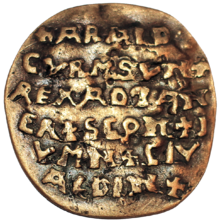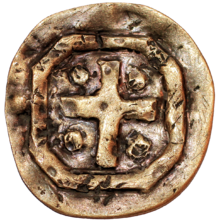Curmsun Disc

The Curmsun Disc is a convex-concave gold disc that gained scholarly attention in 2014 after an 11-year-old Polish girl in Sweden showed it to her history teacher. Some scholars have tentatively dated the disc to the 10th to 12th century, although its authenticity is not universally accepted by historians or archaeologists.[1]
The disk weighs 25.23 grams (0.890 oz) and has a diameter of 4.5 centimetres (1.8 in). The Danish Viking king Harald Bluetooth is mentioned in the inscription of the disc. The disc's characteristics are influenced by Byzantine coins and seals.[2]
Origin
The Curmsun disc was reportedly found as part of a Viking Age hoard discovered in 1841 in the cellar crypt of the ruined church in the village of Wiejkowo in Pomerania (now part of Gmina Wolin, Poland). This location is just east of the bank of the river Dziwna and near the place where the semi-legendary Viking stronghold of Jomsborg stood between the 950s and 1043.
According to Swedish archaeologist Sven Rosborn the entrance to the crypt was accidentally discovered by a 12-year-old Heinrich Boldt, who was playing with some younger children at a construction site near the ruined chapel.[3]
The find consists of five objects today: a silver coin from Otto I's reign, a bracelet in bronze with a dash decoration covering the surface, a fragment of another bronze bracelet, a small stamped piece of gold and the Curmsun Disc itself.[4]
After its original discovery the hoard was left in the crypt until 1945, when a Polish army major, Stefan Sielski, and his brother Michał entered and seized what was left of it. The disc did not appear to be made of gold so it was placed in a box with old buttons. In 2014, Michal Sielski's 11-year-old great-granddaughter showed the disc to her history teacher and it was reported in the press on 5 December 2014.
Interpretation

Researchers have interpreted the inscription on the obverse as: "+ARALD CVRMSVN+ REX AD TANER+SCON+JVMN+CIV ALDIN+".
CVRMSVN is a transliteration from spoken Old Norse via runes into the Medieval Latin alphabet.
Old Norse word in Latin alphabet: G O R M S O N
Written in runes (Younger Futhark): ᚴ ᚢ ᚱ ᛘ ᛋ ᚢ ᚾ
Transliterated to Latin alphabet: C V R M S V N
The same phenomenon could be seen in some coins from York in the tenth century where king is transliterated as CVNVNC but translated as KONUNGR (in English: KONUNGR). Old Norse in coin inscriptions ended after the tenth century.
A full translation of the inscription reads: "Harald Gormson king of Danes, Scania, Jomsborg, town (or bishopric) Aldinburg (Oldenburg in Holstein)".
On the reverse there is an octagonal ridge, which runs around the edge of the object. In the centre of the octagonal ridge there is a Latin cross. There are four dots around the Latin cross. Similar dot markings are common on coins, even on coins from the late 900s. The four dots could possibly symbolize the four evangelists, whose symbols in the Middle Ages had strong associations with the Christ symbolism of the cross.[4]
Dating theories
Around 960s - Harald Bluetooth's second marriage
Danish anthropologist Karen Schousboe conjectures that the Curmsun Disc could be a talisman or medallion, likely created after 963, although it is unclear if the disc is authentic or a fake.[1]
Around 986 - Harald Bluetooth's death
According to a theory by Swedish archeologist Sven Rosborn, the Latin inscription on the obverse of the Curmsun Disc may have been created by a Frankish monk in connection with Harald Bluetooth's death around 986.[4]
Rosborn points out that Adam of Bremen, the only historical source commenting on the death of Harald, says that Harald died in Jumne (Jomsborg) from his wounds. Yet, as Rosborn explains, Jumne probably did not have a Christian church, so Harald's body may have been buried, at least temporarily, in the nearest church located at Wiejkowo. Thus, the disc may have been placed near the burial.
According to Rosborn,
"With the language use that was current at the time of Harald’s life, the inscription CIV + ALDIN should thus be linked with the previous town name [Jumne]. The translation would then be "Jumne in the bishopric Aldinburg". Jumne was after all, according to Adam of Bremen, the place of King Harald's death, so the object’s closing inscription should thus, from a Christian point of view, pinpoint where Jumne was located."[4]
Around 1100 – Harald Bluetooth canonized?
According to Danish archivist Steffen Harpsøe, the disc may have been created by local priests around Jomsborg and Wiejkowo between 1050-1125, if missionaries had canonized Harald Bluetooth. Harpsøe also stated that it is unclear if the disc is genuine.[2]
Authenticity controversy
According to Danish history professor Kurt Villads Jensen, the authenticity of the disc is heavily questionable. It resembles no other known artefact from the Viking age, and it is impossible to precisely date gold objects; even if the alloy is accurate, it might come from a melted down Viking age artefact. According to Jensen: “I believe, however, that it is pure fraud all the way. Immediately. If there is anything genuine in it, Rosborn has done what he could to make it look like a forgery.” Several other Danish professors, including Jes Wienberg and Jens Ulriksen, are equally dubious of the authenticity of the Curmsun disc and the associated Gesta Wuleniensis, and are highly critical of Rosborn's arguments and use of historical sources.[5][1]
Metallurgical analysis
The Curmsun Disc underwent electron microscopic analysis at Lund University in Sweden. The analysis showed a non-homogeneous alloy with a gold content ranging between 83.3-92.8%. The surface and alloy showed characteristics typical for artefacts created during the latest part of the Early Middle Ages. No traces of modern processes or chemicals were discovered. Surface analysis by a gemologist, Jonny Westling, appointed by the Swedish Chamber of Commerce in Stockholm and Lloyd's/Brookfield Underwriting, showed natural inclusions[clarification needed] and patination.[3]
Exhibition
The Curmsun disc is owned by an undisclosed company and deposited at a bank vault in Sweden. The disc's insured value is USD 3.5 million and the valuation has been performed by Jonny Westling, an expert appointed by Swedish Chamber of Commerce and Lloyds/Brookfield Underwriting.[3]
See also
References
- ^ a b c Schousboe, Karen (2014-11-28). "Harold Bluetooth's Talisman - A Sensational Find? Or Fake?". Medieval Histories. Retrieved 2023-07-03.
- ^ a b Harpsøe, Steffen (2015-11-27). "Haraldsguldet: En mystisk guldskive fra fortiden". Siden Saxo. pp. 14–27. Retrieved 2023-07-03.
- ^ a b c Rosborn, Sven (May 16, 2021). The Viking King's Golden Treasure. ISBN 9789198678017 – via Google Books.
- ^ a b c d Rosborn, Sven. "A unique object from Harald Bluetooth´s time. (2015)". Retrieved 2023-07-03.
- ^ Hoffmann, Thomas (2022-08-25). "Har svensk arkæolog bevist, at Harald Blåtand blev begravet med kæmpeskat i Polen?". videnskab.dk (in Danish). Retrieved 2023-07-03.
